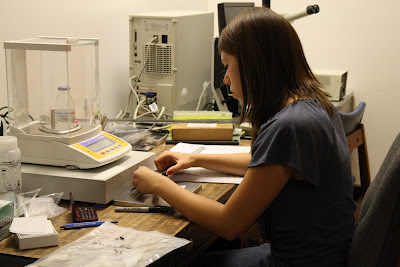The Student Research Apprenticeship Program (SRAP) is a paid summer research program at the University of Wyoming for high school students in tenth through twelfth grade. It is sponsored by Wyoming EPSCoR and funded by the National Science Foundation. This is the fifth of eleven stories about the laboratories where this year’s SRAP students are working.
 |
| Kaycee Perez works with Cathepsin K in Dr. Nair's lab. |
Alexzandria’s work is focused on an enzyme called
protein-tryosine phosphatase 1B (PTP1B) while Kaycee’s research is centered on
another enzyme called Cathepsin K.
PTP1B is an enzyme that prevents the actions of insulin in
the body. It is part of the development of insulin resistance and obesity.
Insulin resistance is when the body does not react to the effects of a normal
amount of insulin, so it creates more insulin in order to have the same effect.
Cathepsin K is an important part of fat formation in the body. Both projects
are looking at how the enzymes impact fatty liver formation in a high-fat diet.
Fatty liver is the accumulation of fat in the liver, most often due to insulin
resistance.
 |
| Alexzandria Steiner works with PTP1B in Dr. Nair's lab. |
In the short amount of time Alexzandria and Kaycee have been
working in Dr. Nair’s lab, they have come to two conclusions about the enzymes.
Alexzandria found that mice without PTP1B do not develop fatty liver formation,
despite being on a high-fat diet. Kaycee, on the other hand, found out that
even without Cathepsin K, the mice developed fatty-liver formation. Her
findings however, indicate that while fatty-liver was formed, the absence of
Cathepsin K increased insulin signaling, meaning that insulin resistance
decreased.
Dr. Nair is pleased by Kaycee and Alexzandria’s work and
their experience in his lab. “The SRAP students get an overview of the process
of scientific research and hands-on training on a variety of techniques,” he
says.
 |
| Kaycee Perez and Alexzandria Steiner in Dr. Nair's lab. |
Alexzandria and Kaycee’s findings are important contributions
to studies about diabetes and obesity. They may help identify future treatments and controls for diabetes, as well as raise more questions
about the molecular mechanics behind diabetes development.
By Kali S. McCrackin
Photos by Beth Cable
By Kali S. McCrackin
Photos by Beth Cable



